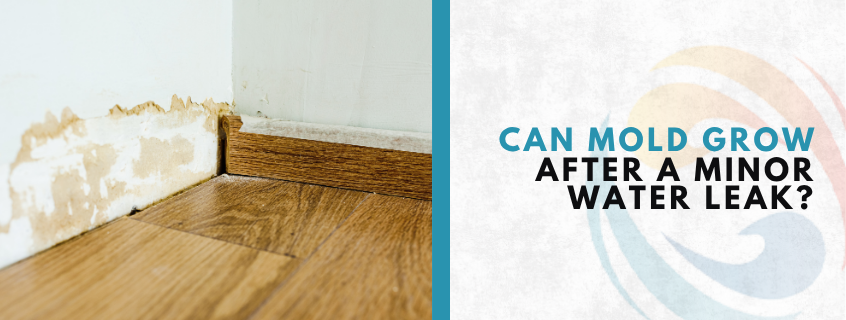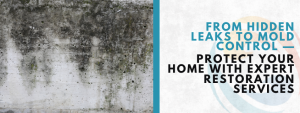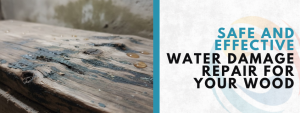
It was just a small drip from the kitchen sink pipe. You wiped the puddle, tightened the fitting, and moved on with your day. But a week later, a musty smell started coming from under the sink. You opened the cabinet, and there it was—mold. At this point, quick action and proper mold removal are essential to stop it from spreading and protect your home.
How Does Mold Start After a Minor Leak?
Mold is sneaky. It loves quiet, dark, and damp places—like under your sink, behind the fridge, or inside your walls. When a pipe drips or a roof leaks, even slightly, that’s all it takes for mold to wake up and start growing.
Here’s how mold after water leak typically starts:
- The leak goes unnoticed: Maybe it’s a pinhole drip under a bathroom vanity or condensation from an AC unit.
- Moisture soaks in: Wood, drywall, and fabric absorb the water.
- Warmth speeds it up: Mold thrives in warm environments—most homes are the perfect temperature.
- Mold spores multiply: Spores are already in the air. They just need moisture to begin colonizing.
- Time allows spreading: Mold can begin growing in just 24–48 hours if conditions are right.
Even if the leak stops, moisture can stay trapped in floors or behind walls. That’s why mold after water leak may show up days or even weeks later.
What Does Mold Look and Smell Like?
You don’t always see it at first. Sometimes you smell it before you spot it. A musty, earthy, or sour odor is a common clue. Mold comes in many forms and colors—black, green, white, brown, even orange.
Common Signs of Mold:
- Dark spots or stains on ceilings or walls
- Musty or stale odor in specific areas
- Peeling paint or bubbling wallpaper
- Allergy symptoms like sneezing or watery eyes indoors
- Warped baseboards or wood flooring
List of Common Indoor Mold Colors:
| Mold Color | Likely Type | Typical Location |
| Black | Stachybotrys | Wet drywall, ceilings |
| Green | Cladosporium | Shower tiles, HVAC |
| White | Aspergillus | Clothing, fabrics |
| Yellow | Serpula | Wood, wallpaper glue |
If you notice any of these signs, especially after even a minor plumbing issue, there’s a good chance you’re dealing with mold after water leak.
Can Mold Be Harmful?
Yes. Mold isn’t just unpleasant to look at or smell—it can also affect your health. While not everyone reacts the same way, mold exposure can cause respiratory symptoms and worsen allergies, especially for kids, seniors, and those with weakened immune systems.
Health problems linked to mold include:
- Sneezing, coughing, or itchy eyes
- Nasal congestion or runny nose
- Asthma attacks or breathing issues
- Headaches or fatigue
- Skin rashes
Long-term mold exposure can lead to more serious health effects. That’s why it’s important to treat mold after water leak seriously—even if the leak seemed small or was quickly fixed.
Where Does Mold Hide After a Leak?
Sometimes the scariest part of mold is not what you can see—but what you can’t. A simple water drip can lead to hidden mold that grows behind walls, beneath tiles, or under carpeting.
Top Hidden Spots for Mold Growth:
- Behind drywall or paneling
- Under carpets and carpet padding
- Inside HVAC ducts
- Beneath kitchen sinks
- Under hardwood floors
- Behind wallpaper
- Inside washing machine basins
If you’ve leaked any of these areas, consider checking for mold or calling in a professional to inspect it. That’s especially true if you suspect mold after water leak but can’t see obvious signs.
How Fast Can Mold Grow After a Leak?
One of the most surprising facts is how quickly mold can grow. It doesn’t need much time at all. Once moisture is present, mold spores can begin forming colonies in as little as 24 hours.
Growth Timeline After a Water Leak:
- Within 24–48 hours: Spores begin attaching to surfaces.
- Day 2–4: Small colonies start forming and may become visible.
- One week: Mold is well-established and begins to spread.
- Two weeks: Strong odors and visible damage may appear.
- Three weeks or more: Mold can affect structural materials and indoor air quality.
This is why addressing a leak immediately is critical. Even if you dry the surface, moisture can remain trapped behind walls or under floors, leading to mold after water leak.
Can You Prevent Mold After a Minor Leak?
Absolutely. The faster you act, the better chance you have of stopping mold before it starts. Prevention doesn’t require special tools—just quick thinking and a little elbow grease.
Steps to Prevent Mold After a Leak:
- Dry the area thoroughly with fans and towels.
- Open windows to improve airflow.
- Use a dehumidifier to remove moisture from the air.
- Check behind walls, floors, or cabinets for hidden damp spots.
- Disinfect surfaces with mold-killing sprays (vinegar, hydrogen peroxide).
- Watch for signs like smells or stains over the next few days.
If the leak involved a lot of water or lasted several hours unnoticed, call a water damage expert. A trained professional knows how to check for hidden water pockets that could lead to mold after water leak.
DIY vs. Professional Mold Removal
When facing mold, the choice between DIY and professional removal depends on the size, location, and severity of the problem. DIY mold removal is often suitable for small patches (under 10 square feet) on non-porous surfaces like tile or glass. Using gloves, masks, and natural cleaners such as vinegar or hydrogen peroxide, homeowners can safely clean and monitor minor growth. However, mold hidden behind walls, spreading across large areas, or linked to water damage requires professional intervention. Certified specialists in Mold Remediation Los Angeles use advanced equipment to detect hidden colonies, contain spores, and restore affected areas safely. They also address the root cause, preventing recurrence. While DIY can save money, professional mold removal ensures long-term safety, thorough cleanup, and peace of mind—especially when health risks or property damage are concerns.
What About Insurance—Is Mold Covered?
Home insurance doesn’t always cover mold cleanup. It depends on what caused the mold. If it came from a covered water event, like a burst pipe, you might be covered. But if it’s from poor maintenance or long-term neglect, most policies won’t help.
Examples of What’s Usually Covered:
- Pipe bursts
- Washing machine overflows
- Water heater leaks
Usually Not Covered:
- Long-term roof leaks
- Poor ventilation
- Flooding from natural disasters (unless you have flood insurance)
It’s important to contact your insurer early. An inspection may be required to determine if the mold is from a covered event. And remember, catching mold after water leak early can reduce damage and improve your chance of coverage.
How Much Does Mold Removal Cost?
The cost of mold cleanup can vary based on the size of the affected area, where it’s located, and how far it’s spread.
Typical Price Ranges:
| Service Type | Average Cost Range |
| Minor surface cleanup | $150 – $500 |
| Moderate removal (1–2 rooms) | $500 – $2,000 |
| Full home remediation | $2,000 – $10,000+ |
These prices don’t include repairing damaged drywall, floors, or cabinets. That’s why catching mold after water leak early can save thousands of dollars in repairs.
Final Tips: How to Avoid Mold in the Future
Once you’ve dealt with mold, the last thing you want is to go through it again. Keep your home dry, clean, and well-ventilated.
Tips to Stay Mold-Free:
- Fix leaks immediately—even tiny ones.
- Use exhaust fans in bathrooms and kitchens.
- Clean and dry spills within 24 hours.
- Monitor humidity levels (keep below 50%).
- Check under sinks, around appliances, and in basements regularly.
- Replace HVAC filters and clean ducts annually.
Taking these small steps can help you avoid the stress and cost of dealing with mold after water leak again. And if you’re ever unsure whether moisture is hiding behind your walls, the best thing you can do is get a professional assessment. Discover how water damage restoration in Los Angeles can help prevent long-term mold problems.
Frequently Asked Questions About Mold After a Water Leak
Can mold grow after a small leak in my home?
Yes. Even a minor leak can lead to mold growth. Mold spores only need moisture, warmth, and time to develop—conditions often present after a drip under a sink, behind walls, or in basements. If the area isn’t dried properly within 24–48 hours, mold can begin forming and spreading.
How do I know if I have mold after a water leak?
Look for a musty odor, dark spots on walls or ceilings, or allergy-like symptoms such as sneezing and itchy eyes. Mold can also hide behind walls or under flooring. If you suspect mold but can’t see it, call a professional for inspection.
What should I do right after discovering a leak to prevent mold?
Act fast. Dry the area thoroughly with towels, fans, or a dehumidifier. Open windows for airflow. Clean hard surfaces with vinegar or hydrogen peroxide. Monitor the area for odor, stains, or warping over the next few days.
Is it safe for me to clean mold myself, or should I call a professional?
If the mold covers less than 10 sq. ft., is on a non-porous surface, and you have no health issues, you can try cleaning it yourself. For recurring, widespread, or hidden mold—or if you have health concerns—professional remediation is strongly recommended.
Will my homeowner’s insurance cover mold cleanup?
It depends on the cause. If it was from a covered incident such as a burst pipe or sudden leak, it’s likely covered. If it resulted from neglect or maintenance issues such as a slow drip or poor upkeep, it usually won’t be covered. Check your policy and contact your insurance provider promptly.






